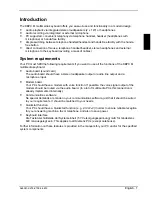
1
Chapter 1: Overview of the DPS16
Chapter 1: Overview of the DPS16
This chapter describes the features of the DPS16 and identifies its parts and functions. It also describes the
DPS16’s unique conceptual design and operating method.
Features of the DPS16
The following list describes the features of the DPS16:
• The DPS16 features a recording section which is capable of 10 track simultaneous recording and 16 track
simultaneous playback, a mixer section of 26 channels, and an internal effect section that enables you to use
four effect channels simultaneously. In this way, the DPS16 can serve as stand-alone music production
equipment that handles everything from recording parts to overdubbing, signal processing, and mixdown.
• The DPS16 supports various recording formats: the standard, non-compressed 16-bit/44.1kHz; 16-bit/48kHz;
and non-compressed 24-bit/96kHz for the first time for this type of recorder.
• The DPS16 provides you with 16 recording/playback tracks (physical tracks) and 250 data storage tracks
(virtual tracks). Switching among virtual tracks (that are assigned to physical tracks) allows you to record
multiple takes of the same part or phrase and later select the best take for mixdown.
• The mixer section is fully loaded with 3-band EQ, Pan, AUX send 1–4, Level, and on/off capabilities. In
addition to 16 TRACK MIX channels that control the output from the recorder tracks, 10 INPUT MIX
channels are available to directly control input signals from the INPUT jacks. You can mix down the signal
from a connected synthesizer and/or sampler.
• Six Q-Link knobs enable you to control mix parameters and effect parameters directly and intuitively without
interrupting the flow of your work.
• The DPS16 has an internal IDE hard disk and allows you to connect up to six SCSI devices (such as external
hard disks and MO drives) to the SCSI connector on the rear panel for recording and data backup. Connecting
a CD-R/RW drive that supports Multi-Media Commands (MMC) enables you to write audio tracks of the
DPS16 to a CD-R/RW disc.
• Connecting a MIDI device, such as a MIDI sequencer, allows for master or slave sync operation. Using MIDI
Machine Control (MMC ) also enables you to remote-control the transport section and the selection/cancella-
tion of recording tracks of the DPS16 from a connected external device.
• Up to 100 locate points in a song can be named and stored. You can immediately jump to any specified locate
point using a simple operation. A “Direct Locate function” that assigns locate points to the keys on the front
panel is also available.
• The DPS16 offers an improved and integrated waveform-level editing function. You can specify track(s) to
edit and perform various editing operations, such as Copy & Paste, Cut & Paste, and Copy & Insert.
• The DPS16 is equipped with a scene memory that stores mix settings. You can create several mix configura-
tions with different balance and EQ settings. You can also adjust the mix-related parameters via MIDI.
Combining this with a MIDI sequencer will enable a mix automation.
• Four-channel multi-effects (optional) selected from among 44 types of effects can be routed via AUX send/
return 1–4, or can be inserted to a specified channel.
About Q-Link
Q-Link is a group of functions that enable intuitive, quick, and easy operation. The DPS16 uses Q-Link to
interface with the Q-Link knobs adjacent to the display (enabling you to mix as if you were using an analog
mixer). Q-Link and Q-Link functions also allow you to perform various tasks quickly in the Main screen.














































